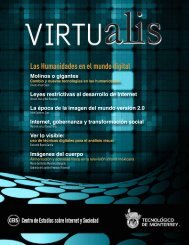P
terranova-network-culture
terranova-network-culture
- No tags were found...
You also want an ePaper? Increase the reach of your titles
YUMPU automatically turns print PDFs into web optimized ePapers that Google loves.
Three Propositions on Informational Cultures 19informational command – where the ultimate target is the control ofwhat audiences think and feel. On the contrary, the informationaldimension of communication seems to imply an unfolding processof material constitution that neither the liberal ethics of journalismnor the cynicism of public relations officers really address.For example, in some ways the informational dimension ofcommunication seems to implicate a production of reality in a waythat does not only involve our capacity to signify – that is, to knowthe world through a system of signs. In as much as informationconcerns the problem of form it also poses the question of theorganization of perception and the production of bodily habits whichit foregrounds with relation to the emergence of social meanings.Within design and architecture, for example, information is alsoabout the active transformation of bodily habits as this takes placearound keyboards and chairs, games, trains and cars, buildingsand small objects with which we perform all kind of daily actions.Information is not about brainwashing as a form of media effect, butit does also involve a level of distracted perception; it thus informshabits and percepts and regulates the speed of a body by pluggingit into a field of action. In this sense, the informational dimensionof communication is not just about the successful delivery of acoded signal but also about contact and tactility, about architectureand design implying a dynamic modulation of material and socialenergies. Information works with forms of distracted perceptionby modulating the organization of a physical environment. 18 Thisactive power of information is everywhere: it is in the interfacesthat relay machines to machines and machines to humans; it isin material objects including chairs, cars, keyboards, and musicalinstruments. It is in bottles and telephones in as much as they lendthemselves in a particular way to the action of a hand. It is not anessence, understood here as a transcendent form, but it indicates thematerial organization of a possible action that moulds and remouldsthe social field. The return of communication to its minimumconditions makes the whole field of culture and society (not simplythe media) open to the informational redesign and hence, to theaction of a code. A cultural politics of information, as it lives throughand addresses the centrality of information transmission, processingand communication techniques, opens up a heightened awareness ofthe importance of minute and apparently inconsequential decisionsas they are implemented in architecture and design, on televisionand the Internet, in medical research and news-making, in personal








